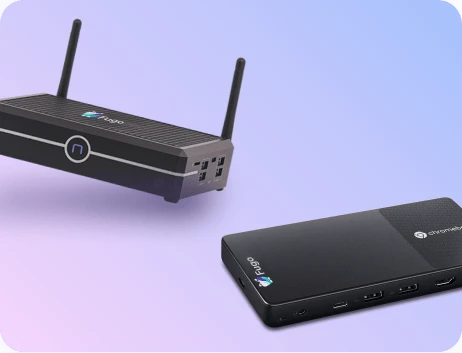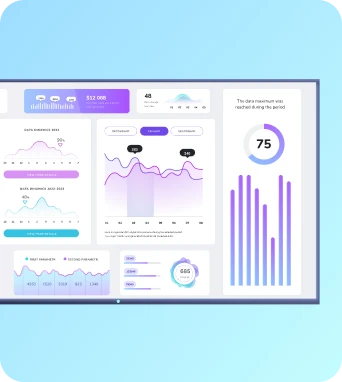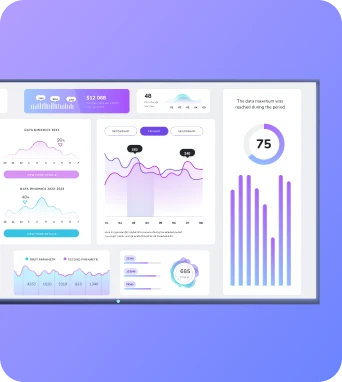If you’re exploring your digital signage options, OptiSigns is likely on your radar. But as with most SaaS tools, what you see on the pricing page isn’t always the full story. There are extra fees, upgrades, and costs worth knowing before you commit — plus software limitations you should know early on.
We’ve gathered everything you need to know about OptiSigns pricing, from its plans and included features to the hidden fees and fine print, so you can evaluate the price tag up front. We’ll also touch on OptiSigns' limitations so you can weigh the pros and cons before you buy.
💡 If OptiSigns doesn’t quite fit your needs, we’ve included an alternative at the end of this guide.
Breaking down OptiSigns pricing and plans

OptiSigns has five pricing plans: Free, Standard, Pro Plus, Engage, and Enterprise.
Here's a breakdown of their costs and features:
Free plan
OptiSigns' Free plan is, well, 100% free. It doesn't cost a dime to start with three screens.
With it, you'll have access to its drag-and-drop content builder, limited app integrations, and the built-in editor.
Just keep in mind its features are significantly limited. As in, there's no way to unlock unlimited storage or access all OptiSigns support without upgrading to the Standard plan. You won't
P.S., unlike Yodeck, where the "free" plan is just a free trial, OptiSigns' Free tier is free forever.
Key features | What's missing |
Upload images, documents, and videos | Free templates |
Remote screen management on web or mobile apps | Device management |
25 basic app integrations | Unlimited users |
1 GB cloud storage | Unlimited storage |
OptiSigns logo on screens | No OptiSigns logo |
Limited content playlists | Full content playlists |
25 apps and integrations | 100+ apps and integrations |
Device realtime online/offline status | Campaign management and advanced playback |
Knowledge base articles and guides | Content automations and integrations |
Device management features | |
QR codes and IoT engagement tools | |
User management and security | |
Branding | |
Email support |
Standard plan
The Standard plan starts at $10 per screen per month for a max of 25 users. You can lower the cost to $9 per screen per month if you're willing to pay annually (aka, all up front).
This tier unlocks everything the Free plan is missing, including unlimited storage, email customer support, and the ability to create playlists and schedule content. OptiSigns also adds 75+ app integrations on this tier so you can connect with other major platforms you're already using. For example, you can plug into Google Slides, social media feeds, or other Google Workspace apps (like Google Drive). These allow you to add more content types or create simple workflows for scheduling or submitting content.
Just keep in mind the Standard plan doesn't come with unlimited users. You can only have up to 25 collaborators — not ideal if you manage multiple locations. Plus, there's no access to content automations, engagement tools, or advanced device management without upgrading. There's no way to control screens from your phone or connect and automate app workflows, for example. You also can't access phone or Zoom-level customer support without paying extra for the next tier.
Key features | What's missing |
Free templates | Content automations and integrations |
Up to 25 Users | Unlimited users |
No OptiSigns logo | QR codes and IoT engagement tools |
Full content playlists | Campaign management and advanced playback |
100+ apps and integrations | Advanced reporting |
Manual playlist control | Advanced device management tools |
User management and security | Branding |
Email support | Phone and Zoom support |
Unlimited storage |
Pro Plus plan
Pro Plus costs $15 per screen per month paid monthly, or $13.50 per screen per month paid annually (roughly $162 for one screen). With it, you get access to OptiSigns' "mid-tier" features, including unlimited users, IoT management, and all reporting and analytics features.
But there are lots of "enterprise" features unavailable on this tier. For example, you can't design digital signage for kiosk applications or set up touchless QR codes. You also can't get 1:1 live support when things go wrong — or easy setup support with dedicated onboarding.
Sure, you'll get a few more data security options, including SAML and Microsoft SSO. But if kiosks and hand-holding are both features you need, prepare to upgrade again to the Engage plan (which we'll cover in the next section).
Key features | What's missing |
Content automations and integrations | Live TV Ads Overlay |
Unlimited users | Enterprise features |
QR codes and IoT engagement tools | Custom data residency options |
Campaign management and advanced playback | Dedicated account manager |
All reporting and analytics features | |
Advanced device management tools | |
All branding features | |
Most user management and security features | |
Phone support |
Engage plan
The Engage plan costs $30 per screen per month paid monthly and $27 per screen per month paid annually. This unlocks an entire category of features (i.e., engagement tools and live TV ads). You'll also get access to 1:1 Zoom support.
This is the highest tier you can get before breaking into the Enterprise plan. You also get a few extra bells and whistles for the price — although keep in mind they're not always applicable to small and growing businesses.
Perhaps most frustratingly, OptiSigns doesn't offer enterprise features or dedicated account management at this level. Compare this to digital signage platforms like Fugo providing Enterprise Assurance Packages to anyone managing 10 screens or more.
Key features | What's missing |
Live TV Ads Overlay | Enterprise features |
All engagement features | Dedicated account manager |
Custom data residency options | |
Zoom support |
Enterprise plan
OptiSigns' top-of-the-line Enterprise plan costs $45 per screen per month on a month-to-month plan. You could reduce this to $40.50 per screen per month when paid annually. Just keep in mind this is still more expensive than other Enterprise plans on other digital signage platforms.
You should also know the Enterprise requires 25 screens minimum. So if you need Enterprise features with just 15 screens, you'll end up paying extra just to unlock what you need.
This also means you can't pay less than $1,125 per month on this plan — not counting hardware, taxes, and hidden fees (which we'll chat about in the section below).
Key features | What's not on any plan |
Enterprise features | Player variables |
Dedicated account management | Event email notifications |
Set screen "sleep" schedule | |
Map preview |
OptiSigns' true costs: hidden fees to know
You can see how OptiSigns' dollars and cents don't always make "sense" for small and growing businesses. If you pardon the pun.
Here are a few other costs you'll want to know up front:
- User maximums: Once you reach a certain user cap in OptiSigns, you'll be forced to upgrade your plan. The Free plan, for example, only has a max of three users. The Standard plan allows up to 25. You'll need the Pro Plus plan to have unlimited users on your account — even if you don't need the features that come with it.
- Hidden hardware costs: OptiSigns charges for hardware as well as software if you sign up for its Managed Device Program. You’ll pay $99.99 upfront per device, plus $15 per month ongoing. And you’ll only get a 50% refund if you return a device within 12 months of purchase. Speaking of hardware costs...
- Restocking/testing fee for returns: If you return a faulty managed device, but OptiSigns decides it’s not actually "incapable of remote repair," they’ll charge you a $100 testing and restocking fee.
- Add-ons: Many of OptiSigns best features are hidden behind extra add-ons. For example, video walls cost an extra $25 per video wall per month. Wireless presentations are $20 per presentation per month. Background music costs $15 per user per month. Fortunately, most digital signage providers don't require you to purchase add-ons for such necessary features.
- Unlisted taxes and price changes: OptiSigns explicitly reserves the right to add sales tax and change prices at any time, even after you’ve subscribed. That means your ongoing costs could rise without prior notice.
- Recurring billing without re-authorization: If you read OptiSigns Terms and Agreements, you'll see the company has the right to automatically renew and charge your payment method for recurring services until you cancel (with no prior approval required each time).
- Additional charges for overages or AI usage: OptiSigns' AI Designer feature may come with usage limits, such as the number of designs, templates, or stored files. If you exceed those limits, OptiSigns reserves the right to impose extra charges or suspend service.
- No refunds for prepaid terms: The terms don’t mention prorated refunds upon cancellation. That means if you cancel midway through your billing period, you likely forfeit the remaining balance.
6 things to keep in mind before committing to OptiSigns
Not sure OptiSigns is the best fit for your small business?
But apart from its cost, OptiSigns also comes with some limitations.
Here's a closer look at what you should expect:
"Free" plan has significant limitations
Yes, OptiSigns has a Free tier that sounds great on paper. But it’s really a starter sandbox more than a long-term solution.
Case in point: You’re limited to three screens, can’t remove OptiSigns branding, and can't access advanced scheduling, storage, and support.
If you want to do much more than test the waters, you’ll have to upgrade sooner than later.
User maximums on specific plans
If you’re managing a growing team, watch out for OptiSigns’ user caps. The Standard plan, for instance, limits you to 25 users total. That might sound fine for the first little bit — until you add in regional managers, marketing teams, IT support, and more.
Need more collaborators? You’ll have to jump to the Pro Plus plan to unlock unlimited users.
It’s a subtle upsell, sure, but one that can push your total cost up if you’re expanding.
"Best performance" requires expensive devices
As mentioned earlier, OptiSigns requires specific hardware or operating systems to run. It works on most smart TVs, Android devices, and Windows setups:
- Android, Windows, Mac, Linux, Chrome OS, and Fire TV
- Media players like Amazon Fire Stick or Raspberry Pi
But you’ll get “best performance” only with OptiSigns’ proprietary players. OptiSigns offers:
- OptiStick Player: $79.99 per device
- OptiSigns Pro Player: $299.99 per device
- OptiSigns ProMax Player: $599.99 per device
Something to keep in mind if you have lots of screens and limited budget.
No truly unlimited cloud storage
OptiSigns limits you to 10 GB of cloud storage per paid screen on your account. So if you have three paid screens, you'll have 30 GB of storage space. This is roughly the length of one 15 second video — and likely not enough as your content scheduling needs grow.
If you need more than that, you'll need to email support. Just keep in mind this may also cost extra, although this isn't clear from the support doc page.
Limited pre-made templates
If you’re not a designer, this one might sting a little. OptiSigns’ template library is locked behind paid plans. Even then, it’s pretty limited compared to competitors.
Free users can only access a handful of static templates, while Standard and Pro Plus users get access to more layouts (but no native video templates). That means you’ll need to create dynamic content yourself — which can be time-consuming if you’re not design-savvy and need to create video content for digital menus and other content displays.
Steep learning curve
OptiSigns isn’t exactly plug-and-play. Its interface is powerful, but not the most intuitive, especially for first-timers or non-technical users.
Between configuring devices, content scheduling, managing screen groups, and setting up automations, it can take a while to get comfortable. There’s a help center and community forum, sure, but live support is only available on higher tiers. This means you’ll be largely on your own at first.
No need to take our word for it, though.
See what real-life users had to say:
- "Some parts of the interface, like scheduling, take a little bit of a learning curve." — G2
- "There is a slight learning curve when first setting up more advanced features, and occasional syncing delays can happen if the internet connection is unstable." — G2
- "Not entirely user friendly when using the website." — G2
- "The only thing I dislike about OptiSigns is that it can be tricky to create graphics within the platform." — G2
Fugo: the best OptiSigns alternative
Between limited signage templates, hardware dependencies, and expensive feature caps, it’s easy to see why teams explore OptiSigns alternatives.
Including platforms like Fugo. 😉
You can think of Fugo as the Canva of digital signage: simple, flexible, and powerful enough for any organization. We're designed to work seamlessly with your existing hardware, supporting everything from office dashboards and internal communications to menu boards and retail promotions.
Fugo makes it easy to display content across multiple screens from anywhere in the world with our cloud-based software. Plus, we're secure, scalable, and affordable for businesses of any sizes.
So if you're ready to see what makes Fugo the go-to OptiSigns alternative. . .
Learn why more businesses are switching to Fugo.ai.
FAQs about OptiSigns pricing
Q: Does OptiSigns offer a free plan?
Yes, OptiSigns offers a Free plan that lets you manage up to three screens at no cost. You’ll get access to basic templates, drag-and-drop content tools, and limited app integrations.
But you should know the Free plan comes with several limitations. For example, you'll need to include OptiSign branding on your screens. There's also restricted storage (1 GB) and no access to advanced features like automations or remote device management.
To remove those limits, you’ll need to upgrade to a paid plan.
Q: How much does digital signage cost?
Digital signage software typically costs between $10 and $40 per screen per month, depending on the features and level of support you need.
Keep in mind there may be discounts available. Fugo, for example, offers discounts to Startups, Educators, Non-Profits, and Churches.
Q: How much does OptiSigns LED hardware typically cost?
OptiSigns sells its own hardware players for $79.99 to $599.99 per device. Or, you can pay for them separately through its Managed Device Program (MDP).
Here’s what you can expect to pay:
- $99.99 per device (one-time setup fee)
- $15 per month per device (for ongoing management and updates)
Q: What hardware is needed for OptiSigns?
OptiSigns is compatible with most operating systems, including Android, Windows, Mac, Linux, Chrome OS, and Fire TV. You can also use third-party devices like the Amazon Fire Stick or Raspberry Pi.
That said, OptiSigns recommends its own OptiStick Player, OptiSigns Pro Player, or OptiSigns ProMax Player for best performance. Just keep in mind these come at an additional cost.





